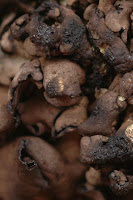 The predicted rain started before dawn and persisted more-or-less all day.
The predicted rain started before dawn and persisted more-or-less all day.
Andy Acton and Anna Griffiths are leading the excursion. About 20 of us meet up at the church which overlooks the wood which is a Scottish Wildlife Trust reserve occupying a long, straight, narrow ridge. Most of it is a closed canopy of hazel with a scattering of standard trees, some of which are also hazel – an unusual sight. 
 The wood is stacked with rarities but with such poor weather everything is sopping wet, lenses fog up and searching is harder. I don’t find any of the Scotland endemics (I wanted to snap a picture of Graphis alboscripta) but Andy identifies Leptogium brebissonii,
The wood is stacked with rarities but with such poor weather everything is sopping wet, lenses fog up and searching is harder. I don’t find any of the Scotland endemics (I wanted to snap a picture of Graphis alboscripta) but Andy identifies Leptogium brebissonii,  Thelotrema petractoides and Pyrenula laevigata which are new to me. In addition to the usual Scottish species I find a tiny scrap of Pseudocythellaria crocata and spot a beautiful parasitic fungus (Nectriopsis lecanodes) on Lobaria virens.
Thelotrema petractoides and Pyrenula laevigata which are new to me. In addition to the usual Scottish species I find a tiny scrap of Pseudocythellaria crocata and spot a beautiful parasitic fungus (Nectriopsis lecanodes) on Lobaria virens.



The incredible diversity of this wood derives from its great age and continuity. It is suspected that there has been hazel woodland here ever since it was first colonised soon after the end of the ice age. Moreover, there has been little management, maybe some selective cutting rather than clear-felling, and appropriate grazing. The Hazel has been allowed to do its own thing – forming new stems continually to replace gaps in the canopy and hence always providing a  humid, closed canopy and new substrate close by for lichens to re-colonise. Another thought: being a linear feature, there is a high proportion of woodland edge for species which prefer more open and better-lit conditions. Another striking feature is the frequency of the rare and spectacular hazel gloves fungus (Hypocreopsis rhododendri), another indicator of woodland continuity. For a much more detailed article about hazel and lichens see: http://www.treesforlife.org.uk/tfl.hazel_scottish.html
humid, closed canopy and new substrate close by for lichens to re-colonise. Another thought: being a linear feature, there is a high proportion of woodland edge for species which prefer more open and better-lit conditions. Another striking feature is the frequency of the rare and spectacular hazel gloves fungus (Hypocreopsis rhododendri), another indicator of woodland continuity. For a much more detailed article about hazel and lichens see: http://www.treesforlife.org.uk/tfl.hazel_scottish.html
The visit ends and we go our separate ways. It has been fun getting to know new people even though just for a morning. After lunch I check out an old record of hazel gloves in dense hazel on the precipitous coastal cliffs (far right of picture - a good example of ‘slope hazelwood’ I suppose!). I didn’t find it but it was an interesting challenge to even get into the woods at all.

Places like Ballachuan hazelwood provide inspiration and a wonderful insight into how nature works when its not messed around with too much.

 But I wonder if it gets boring after you have felled, snedded and cut-to-size your 10,000th tree.
But I wonder if it gets boring after you have felled, snedded and cut-to-size your 10,000th tree.
 It must be the combination of an ideal substrate, high rainfall and the humid shelter provided by the forest that allows them to grow so well and there are hundreds of miles of forest roads with bank sides perfect for growing them.
It must be the combination of an ideal substrate, high rainfall and the humid shelter provided by the forest that allows them to grow so well and there are hundreds of miles of forest roads with bank sides perfect for growing them.

 There is definitely more in the forest than just the trees.
There is definitely more in the forest than just the trees. 




 Andy Acton showed me Pertusaria ophthalmiza.
Andy Acton showed me Pertusaria ophthalmiza. 






 The car isn’t properly fixed all week so we can only go a few miles before over-heating. We check out Gairloch and find the Mountain Coffee Company café – well worth a visit – full of outdoorsy character, more caffeine-based beverages than you can shake a stick at, a great book shop and donations to the John Muir Trust. Fab place.
The car isn’t properly fixed all week so we can only go a few miles before over-heating. We check out Gairloch and find the Mountain Coffee Company café – well worth a visit – full of outdoorsy character, more caffeine-based beverages than you can shake a stick at, a great book shop and donations to the John Muir Trust. Fab place.









